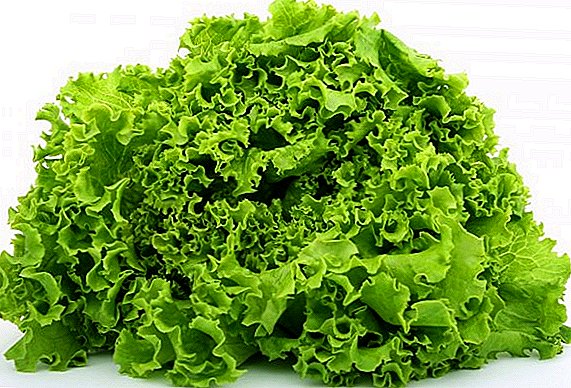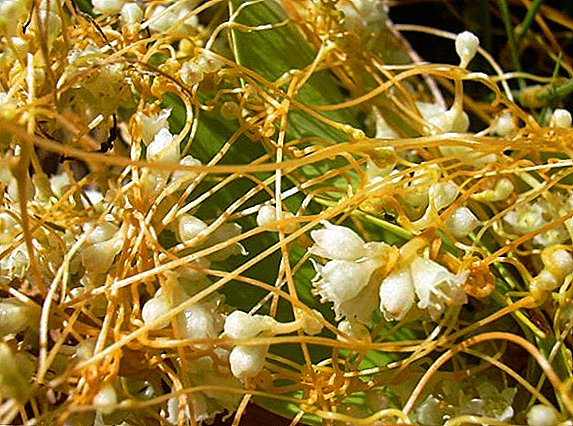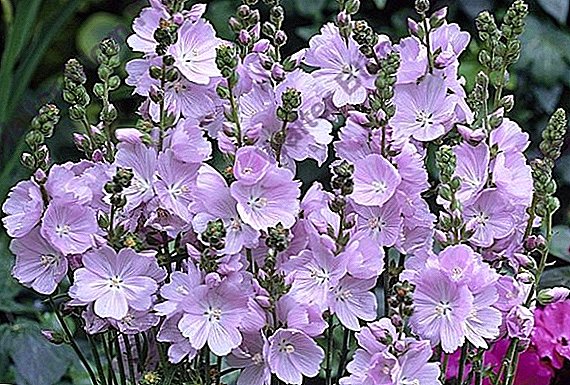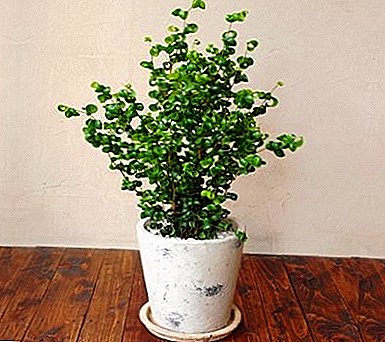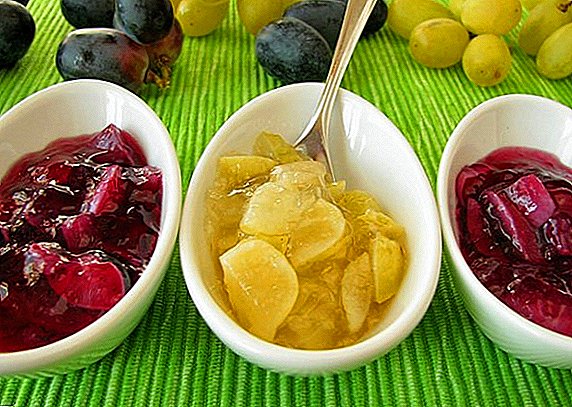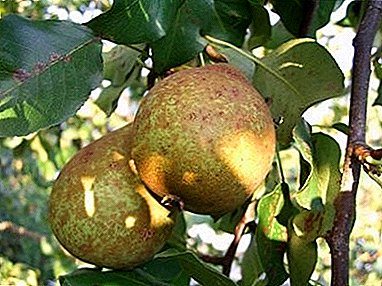
The pear is a very tasty and useful fruit which enjoys wide popularity around the world.
Pear came to Russia from ancient Persia and was widely spread throughout the country.
Marble pear is one of the most popular varieties of pears that are grown on Russian lands.
What kind is it?
There are several criteria for distinguishing varieties of pear plants, the main ones are:
- fruit ripening season;
- crown shape;
- the height of the trees.
Terms of ripening
When does it ripen? Pear Marble refers to the early-autumn varieties, as its fruits usually ripen in early September. These trees have an average height and a pyramidal crown.
The following pear varieties also ripen in autumn: Thumbelina, Larinska, Uralochka, Bere Bosk and Silent Don.
Breeding history and breeding region
 One of the most famous pear breeders in Russia was I.V. Michurin. It was he who managed to bring the only winter variety of pears that can grow in the Russian climate. This variety was named Bere winter Michurina.
One of the most famous pear breeders in Russia was I.V. Michurin. It was he who managed to bring the only winter variety of pears that can grow in the Russian climate. This variety was named Bere winter Michurina.
A little later, the breeders A.M. Ulyanischeva and GD Non-road, working at the gardener's station in the city of Rossosh, located in the Voronezh region, successfully applied the knowledge and experience of Michurin and crossed a winter Bere pear tree with a variety called Forest beauty.
Thus, a new variety was bred - Marble Pear. In 1965, this variety was entered in the State Register. It began to grow in the Central, Lower Volga, Volga-Vyatka and Central Black Earth regions of the country.
Appearance
The Marble Pear tree can be distinguished by its powerful branches, medium height and pyramidal crown, which is wider at the base. The bark of this tree has a gray-green color. Marble pear has a weak tendency to form shoots. They are red-brown in color and directed upwards.
The shoots are densely covered with light colored lentils. The buds are triangular and brown in color. The flowers of the tree initially have a white color, but during the formation of fruits become more pinkish. Inflorescences are umbrella-like and consist of eight to nine small flowers.
Pear "Marble": description of the variety and photos
This pear variety has smooth light green leaves of medium size and ovoid shape, located at an acute angle to the shoot. Fruiting Marble pears are referred to the ringed type, since its fruits usually grow on ringworms located on two to four young branches.
 They have a regular round-conical shape and a smooth surface. Fruits have a fairly dense skin, under which are small patches of rusty color.
They have a regular round-conical shape and a smooth surface. Fruits have a fairly dense skin, under which are small patches of rusty color.
The main color of the fruit is greenish-yellow, but on the side of the pears of the Marble variety there is a brown-red marble spot, due to which this variety was named just that way. The fruits of the Marble pear have wide, medium-sized stems.
Fruit pulp may have a cream or white color and is characterized by a coarse-grained structure. The seeds are light brown in color and are found in small quantities in the fruit.
Marble pears have a sweet taste and a pleasant aroma and belong to the dessert type of pear.
Photo pears "Marble":






Specifications
Marble pear usually begins to give fruit in the sixth to seventh year after budding and is characterized by high yield. Its fruits usually ripen in early September, and the consumer period lasts about three to four weeks. Removed fruits can be stored for sixty to seventy days. They have a high level of transportability and good commodity qualities.
Factors that can reduce yields are dry weather and strong gusts of wind, due to which pears can crumble. The marble pear is characterized by average frost resistance.
Rogneda, Duchess, Sverdlovchanka, Feeriya, Lel and Chizhovskaya demonstrate good frost resistance.
One of the advantages of the Marble pear is its resistance to scab, powdery mildew and fruit rot. Pearl varieties can be used as pollinators for Marble pears. Cathedral, Severyanka, Oryol summer and Oryol beauty.
Planting and care
 Marble pears are recommended to be planted either in spring or in autumn - about a month before the first frost. The most favorable for the seedlings of this tree are loamy soil.
Marble pears are recommended to be planted either in spring or in autumn - about a month before the first frost. The most favorable for the seedlings of this tree are loamy soil.
It is in this soil Marble pear guaranteed to provide you with a good harvest, if you follow the rules of caring for her.
If you decide to plant Marble pear in clay soil, in the pit for planting is mandatory add peat, compost and river sand large size.
This will enable the seedling to develop normally, satisfying its need for air. For sandy soils, it is necessary to use additives such as humus, peat and compost.
The depth of the holes for planting seedlings should be at least seventy centimeters, and the diameter should be one meter. It is advisable to dig a hole a few days before the planned landing. At the bottom of the pit, you can throw walnut husks and tin cans.
IMPORTANT! If you are going to plant Marble soil in the place next to which the groundwater lies, you must make a ditch to drain these waters, otherwise the tree may die.
For reinsurance is better to plant seedlings on small mounds. Next to the Marble Pear you can plant various vegetable crops with the exception of corn and sunflower. These tall-stem cultures draw from the soil practically all the nutrients needed by the pear tree.
 Seedlings should be watered regularly, and fertilizer in the first year of planting is not necessary to use. Mature trees require watering several times throughout the spring and summer. Sprinkling is the most favorable method of irrigation.
Seedlings should be watered regularly, and fertilizer in the first year of planting is not necessary to use. Mature trees require watering several times throughout the spring and summer. Sprinkling is the most favorable method of irrigation.
To do this, you can dig a groove around the trunks, the depth of which should be about fifteen centimeters and carefully pour water into it. For watering one square meter of pear planting, you will need two or three buckets of water.
After watering, and also after a rain, it is necessary to free pristvolny circles from weeds.
In March, it is necessary to prune pears, removing old branches and shortening the remaining ones. This will help prevent crown thickening and serve as a stimulant for the formation of new buds.
At the end of April, the Marble Pear needs to be sprayed. The first spraying should be carried out during the bud break, which will help protect the tree from pests and various diseases. Spray the tree a second time should be when it appears buds. For spraying, you can use drugs such as "Fury", "Strobe" and "Inta-Vir".
In May, it is necessary to begin to engage in the enrichment of the soil with trace elements For this you can use saltpeter, urea, copper sulfate and boric acid solution. For an adult tree, it is necessary to conduct tinning - cutting grass around it and feeding the soil with nitrogen. Do not forget that grass considerably drains the soil. To prepare the tree for the winter, you can plant a green manure, which will decompose during the autumn and enrich the soil with necessary substances.
The main element of Marble pear care in the summer is regular watering of the grooves.
In September-October, it is advisable to whitewash the trunks, and iron red lead should be used to paint wounds on tree bark. November is an excellent time to fertilize the soil.
To do this, you can use substances such as compost, potassium, superphosphate, dolomite, ash, sodium chloride, salt and lime. Fertilizers must be laid out around the pear or around the perimeter of its crown.
In the winter months, trees can be warmed with snow to protect them from freezing, and young seedlings need hilling soil.
Diseases and pests
 Marble pear is highly resistant to powdery mildew and //selo.guru/ptitsa/bolezni-p/gribkovye/parsha.html, but it still needs certain preventative measures of protection.
Marble pear is highly resistant to powdery mildew and //selo.guru/ptitsa/bolezni-p/gribkovye/parsha.html, but it still needs certain preventative measures of protection.
To do this, in the autumn period they dig up the near-trunk circles, clearing them from fallen leaves, and in the spring period they clean off the old bark from the tree trunk, making room for a new one. To protect the trunk of a tree from rodents, you can use a shag or tobacco.
Marble pear is a unique variety of this fruit crop. If you treat her care responsibly, she will definitely reward you with a huge amount of tasty and juicy fruits.
Do not neglect the enrichment of the soil with minerals and spraying trees to protect against parasites and diseases. Carefully monitor the condition and growth of their trees, and then they will delight you for a long time.
The following varieties are resistant to diseases: Limonka, Lira, Northenian Red-cheeked, Moscow early and Noyabrskaya.




